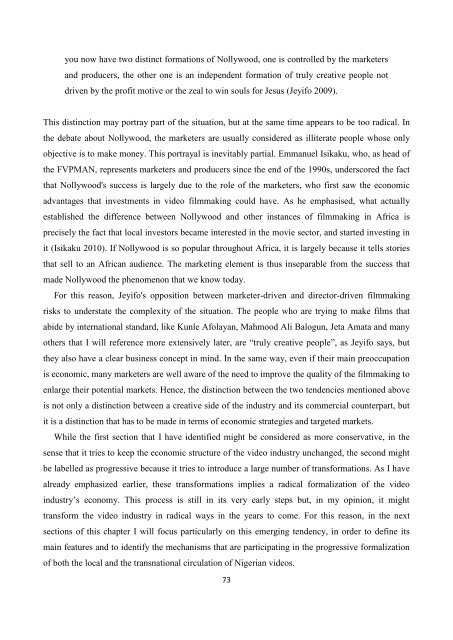You also want an ePaper? Increase the reach of your titles
YUMPU automatically turns print PDFs into web optimized ePapers that Google loves.
you now have two distinct formations of Nollywood, one is controlled by the marketersand producers, the other one is an independent formation of truly creative people notdriven by the profit motive or the zeal to win souls for Jesus (Jeyifo 2009).This distinction may portray part of the situation, but at the same time appears to be too radical. Inthe debate about Nollywood, the marketers are usually considered as illiterate people whose onlyobjective is to make money. This portrayal is inevitably partial. Emmanuel Isikaku, who, as head ofthe FVPMAN, represents marketers and producers since the end of the 1990s, underscored the factthat Nollywood's success is largely due to the role of the marketers, who first saw the economicadvantages that investments in video filmmaking could have. As he emphasised, what actuallyestablished the difference between Nollywood and other instances of filmmaking in Africa isprecisely the fact that local investors became interested in the movie sector, and started investing init (Isikaku 2010). If Nollywood is so popular throughout Africa, it is largely because it tells storiesthat sell to an African audience. The marketing element is thus inseparable from the success thatmade Nollywood the phenomenon that we know today.For this reason, Jeyifo's opposition between marketer-driven and director-driven filmmakingrisks to understate the complexity of the situation. The people who are trying to make films thatabide by international standard, like Kunle Afolayan, Mahmood Ali Balogun, Jeta Amata and manyothers that I will reference more extensively later, are “truly creative people”, as Jeyifo says, butthey also have a clear business concept in mind. In the same way, even if their main preoccupationis economic, many marketers are well aware of the need to improve the quality of the filmmaking toenlarge their potential markets. Hence, the distinction between the two tendencies mentioned aboveis not only a distinction between a creative side of the industry and its commercial counterpart, butit is a distinction that has to be made in terms of economic strategies and targeted markets.While the first section that I have identified might be considered as more conservative, in thesense that it tries to keep the economic structure of the video industry unchanged, the second mightbe labelled as progressive because it tries to introduce a large number of transformations. As I havealready emphasized earlier, these transformations implies a radical formalization of the videoindustry’s economy. This process is still in its very early steps but, in my opinion, it mighttransform the video industry in radical ways in the years to come. For this reason, in the nextsections of this chapter I will focus particularly on this emerging tendency, in order to define itsmain features and to identify the mechanisms that are participating in the progressive formalizationof both the local and the transnational circulation of Nigerian videos.73
















